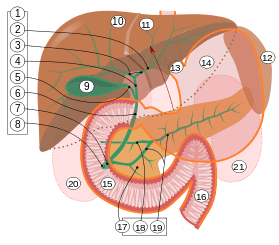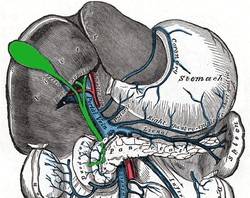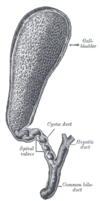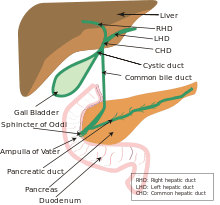Common hepatic duct
| Common hepatic duct | |
|---|---|
 1: Right lobe of liver 2: Left lobe of liver 3: Quadrate lobe of liver 4: Round ligament of liver 5: Falciform ligament 6: Caudate lobe of liver 7: Inferior vena cava 8: Common bile duct 9: Hepatic artery 10: Portal vein 11: Cystic duct 12: Common hepatic duct 13: Gallbladder | |
| Details | |
| Latin | ductus hepaticus communis |
| Identifiers | |
| Gray's | p.1197 |
| Dorlands /Elsevier | d_29/12314882 |
| TA | A05.8.01.061 |
| FMA | 14668 |
| Anatomical terminology | |

9. Gallbladder, 10–11. Right and left lobes of liver. 12. Spleen.
13. Esophagus. 14. Stomach. Small intestine: 15. Duodenum, 16. Jejunum
17. Pancreas: 18: Accessory pancreatic duct, 19: Pancreatic duct.
20–21: Right and left kidneys (silhouette).
The anterior border of the liver is lifted upwards (brown arrow). Gallbladder with Longitudinal section, pancreas and duodenum with frontal one. Intrahepatic ducts and stomach in transparency.
The common hepatic duct is the duct formed by the convergence of the right hepatic duct (which drains bile from the right functional lobe of the liver) and the left hepatic duct (which drains bile from the left functional lobe of the liver). The common hepatic duct then joins the cystic duct coming from the gallbladder to form the common bile duct. The duct is usually 6–8 cm length and 6mm in diameter in adults.[1]
Clinical significance
The hepatic duct is part of the biliary tract that transports secretions from the liver into the intestines. It carries more volume in people who have had their gallbladder removed.
It is an important anatomic landmark during surgeries such as gall bladder removal. It forms one edge of Calot's triangle, along with the cystic duct and the cystic artery. All constituents of this triangle must be identified to avoid cutting or clipping the wrong structure.
Additional images
-

Common hepatic duct
-

The portal vein and its tributaries.
-

The gall-bladder and bile ducts laid open.
-

-
Common hepatic duct
References
- ↑ Gray's Anatomy, 39th ed, p. 1228
External links
- Anatomy photo:38:03-0302 at the SUNY Downstate Medical Center - "Stomach, Spleen and Liver: Contents of the Hepatoduodenal Ligament"
- Common+hepatic+duct at eMedicine Dictionary
- Illustration
| ||||||||||||||||||||||||||||||||||||||
